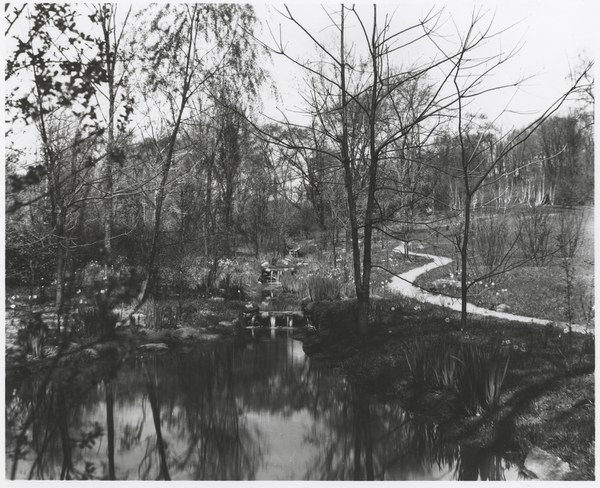Dumbarton Oaks Park refers to the 27-acre parcel of land that Robert and Mildred Bliss donated to the National Park Service in 1940. The acreage is now considered a part of Rock Creek Park. When it was part of the Bliss estate, the park belonged to Beatrix Farrand’s garden design. It served as a rustic counterpoint to the complex and formal garden areas close to the mansion.
A stream cut through the ravine at the bottom of the north-facing hill, and Farrand designed a stone clapper bridge to cross it. Along the water and through the naturalistic woodland, Farrand planted an undergrowth of flowers like azaleas, mountain laurel, and rhododendrons that proved difficult to keep up even during the Bliss years. Farrand designed a circular walk through the wilderness of the park, which began at the stone bridge and followed the water to the rustic Stream Arbor. The stream was dammed up at eighteen points to create still pools and minor falls along the path. For the most part, the design in the valley followed the natural topography of the park.
Compared to the terraced garden rooms near the Bliss residence, Farrand’s designs in Dumbarton Oaks Park enhanced rather than modified the wild landscape. However, even with so little necessary upkeep, the National Park Service found it difficult to maintain the deliberate plantings and design aesthetic present in the Park in 1940. The Great Depression had only recently ended and the nation was at war with Hitler, and gardens received very little funding.
A few informally designed garden areas were lost after the National Park Service took control of the park, including the Hazel Walk and Wall Garden. Beatrix Farrand first suggested the Hazel Walk in her initial 1922 letter to Mildred Bliss. A tree-lined path leading away from Fairview Hill into Dumbarton Oaks Park became the realization of that idea. The Wall Garden featured heathers, ferns, and blueberries at the base of a low stone retaining wall north of Fairview Hill. By 1946, neither garden design existed. Farrand’s parkland was left to the elements until community efforts in the 1990s began a push to return the pathway, stream, and original structures to their original design. The Dumbarton Oaks Park Conservancy, created in 2010, now carries out these conservation and restoration projects.
A number of Bliss-era structures remain in Dumbarton Oaks Park. An old stone pump house, the clapper bridge, and the Forsythia Steps Gate are all Beatrix Farrand designs. The rustic arbor at the end of the woodland path is colloquially known as the Gray Arbor; it was built in 1937 as a memorial to William James Gray, the first superintendent of Dumbarton Oaks’ gardens. It still bears a plaque that the gardeners designed in Gray’s memory, under guidance from Mildred Bliss and Beatrix Farrand. The Park is also final resting place to six dogs and two horses who once belonged to the Blisses.

